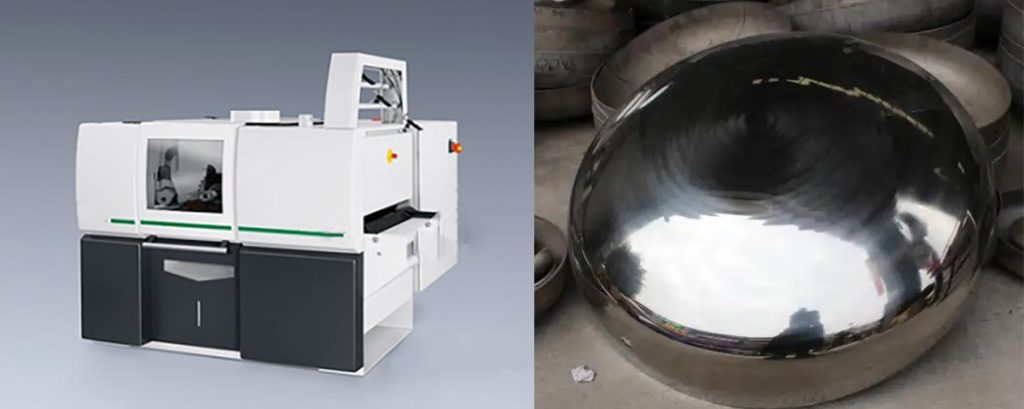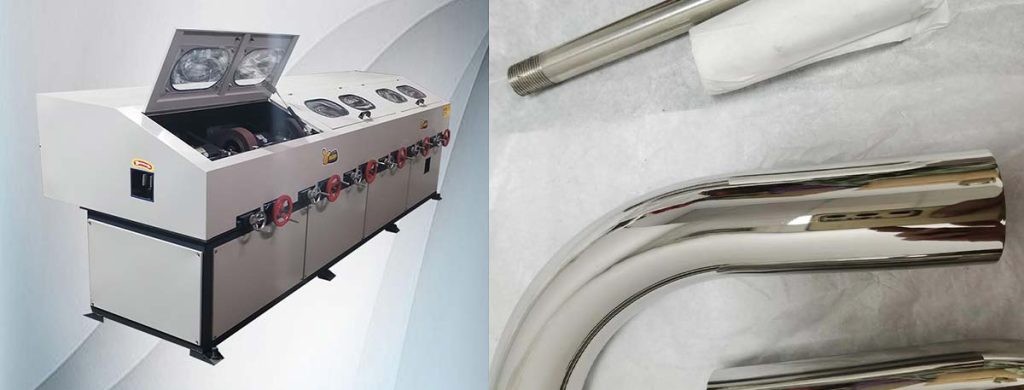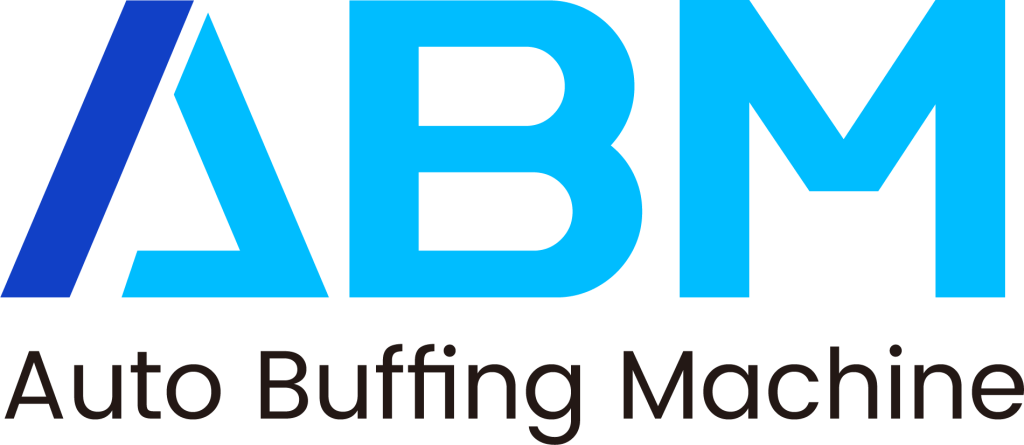

A polishing and buffing machine relies on a dedicated system that delivers lubrication to critical moving parts. This process reduces friction and helps maintain optimal performance. Industry research shows that proper lubrication in these machines lowers polishing-induced temperature by about 30% and decreases residual stress by roughly 20%. These improvements lead to smoother finishes and help extend the lifespan of the equipment. Consistent lubrication also minimizes mechanical and thermal damage, making the polishing and buffing machine more efficient and reliable.
Key Takeaways
- Lubrication reduces friction and heat in polishing machines, which protects parts and improves machine performance.
- Proper lubrication extends machine life by preventing wear and overheating during buffing and polishing.
- Automatic lubrication systems deliver consistent oil flow, reducing maintenance time and preventing machine breakdowns.
- Regular cleaning and inspection of lubrication parts keep the system effective and ensure high-quality polishing results.
- Using the right lubricant type and applying it correctly supports smooth operation and better surface finishes.
Purpose
Friction and Wear
Lubrication plays a vital role in reducing friction and polishing wear in every buffing operation. When machine parts move against each other, friction generates heat and causes surface damage. Lubrication forms a protective film that separates moving surfaces. This film minimizes direct contact between microscopic roughness, known as asperities. In a polishing and buffing machine, finely polished machine surfaces allow for a thinner lubricating film. Lower viscosity lubricants can then be used, which reduces viscous drag and improves energy efficiency. Clean lubricants, filtered to remove suspended particles, prevent abrasive wear. Hard contaminants can act like polishing compounds and increase polishing wear if not removed. The right lubricant and additives help maintain surface integrity and reduce friction. Incorrect additives may cause excessive polishing wear by chemically attacking surfaces. Lubrication, both physically and chemically, protects machine components during buffing and polishing.
Key Benefits of Lubrication in Buffing and Polishing Machine:
- Reduces friction, wear, and tear on moving parts such as bearings and joints
- Ensures smooth operation of buffing and polishing machines
- Extends the lifespan of mechanical components
- Maintains machine efficiency and prevents breakdowns
Overheating Prevention
Buffing and polishing generate significant heat due to friction. Without proper lubrication, this heat can build up quickly and cause overheating. Overheating leads to thermal damage, increased polishing wear, and possible machine failure. Lubrication reduces friction at critical points, such as bearings and joints, which helps control temperature during the polishing process. By keeping these areas cool, lubrication ensures that the buffing machine operates smoothly and safely. Consistent temperature control also preserves the quality of the polished machine surfaces and prevents heat-related defects.
Polishing Process Support
The polishing process relies on precise movement and consistent pressure. Lubrication supports this by allowing machine parts to move freely without sticking or excessive resistance. Smooth operation ensures that the buffing wheels and abrasive materials interact evenly with the workpiece. This reduces polishing wear and helps achieve a uniform finish. Lubrication also affects the interaction between abrasive materials and workpieces. It prevents abrasive particles from embedding in the surface, which could cause scratches or uneven polishing. Daily maintenance with proper lubrication keeps the buffing and polishing process efficient and reliable, resulting in high-quality finishes and longer machine life.
Components
Reservoirs
Reservoirs store the lubricant or coolant that the polishing and buffing machine needs. These tanks hold enough fluid to supply the system during long periods of operation. A well-designed reservoir keeps the lubricant clean and at the right temperature. Some reservoirs include sight glasses or level indicators. These features help operators check fluid levels quickly. A stable supply of lubricant from the reservoir ensures the machine runs smoothly and avoids sudden stops.
Pumps and Delivery
Pumps move the lubricant from the reservoir to the parts that need it. They create the pressure needed to push the fluid through the system. Some machines use gear pumps, while others use piston or diaphragm pumps. The choice depends on the type of lubricant and the machine’s requirements. Delivery systems often include valves that control the flow rate. This setup allows the machine to deliver a continuous flow of lubricant or coolant to the polishing tool. Consistent delivery prevents overheating and extends the tool’s lifespan, which helps maintain surface quality during operation.
Lines and Nozzles
Lines and nozzles guide the lubricant to the exact spots where it is needed. Flexible hoses or rigid pipes carry the fluid from the pump to the moving parts. Nozzles direct the lubricant onto bearings, gears, or the polishing tool itself. Proper placement of lines and nozzles ensures every critical area receives enough lubrication. Operators can adjust some nozzles to fine-tune the flow and coverage. This precision supports efficient operation and reduces waste.
Filters and Seals
Filters remove impurities and contaminants from the lubricant before it reaches the machine’s moving parts. Clean lubricant prevents abrasive wear and protects the system from damage. Seals keep the lubricant inside the system and block dirt or moisture from entering. They also help maintain pressure and prevent leaks. Filters and seals work together to ensure the lubrication system stays effective. Regular maintenance, such as checking filter condition and replacing worn seals, keeps the machine reliable and efficient.
Tip: Clean filters and intact seals are essential for preventing premature wear and maintaining optimal machine performance.
Operation
Lubricant Delivery
A polishing and buffing machine depends on precise lubricant delivery to maintain smooth operation. The system directs lubricant to all moving parts, including bearings, gears, and the buffing spindle. Pumps draw lubricant from the reservoir and push it through lines and nozzles. Operators can adjust flow rates to match the demands of different buffing tasks. This flexibility ensures that each part receives the right amount of lubrication during polishing. Clean lubricant flows continuously, reducing friction and heat at contact points. The system prevents dry spots, which can cause rapid wear or overheating. Consistent lubricant delivery supports both the efficiency and the longevity of the polishing and buffing machine.
Tip: Regularly check lubricant levels and flow to avoid interruptions during buffing and polishing operations.
Polishing and buffing machine often uses a centralized lubrication system. This system automatically services all moving parts and bearings. It coordinates lubricant distribution with the machine’s operation. Automated delivery ensures that every critical area receives consistent lubrication. This approach increases efficiency and extends the lifespan of vital components. Operators spend less time on manual lubrication, which reduces the risk of human error.
Automatic Systems

Automatic lubrication systems have become standard in many polishing and buffing machines. These systems use sensors and timers to control when and how much lubricant is delivered. The machine’s control panel allows operators to set intervals and flow rates. Once programmed, the system works in the background during buffing and polishing cycles. Sensors monitor lubricant pressure and flow. If the system detects a blockage or low level, it alerts the operator. This proactive approach prevents damage and reduces downtime.
Automatic systems also help maintain a clean work environment. They deliver only the necessary amount of lubricant, which minimizes spills and waste. The integration of lubrication with machine controls ensures that the system operates only when needed. This coordination saves energy and reduces lubricant consumption. Operators can focus on the quality of the buffing and polishing process, knowing that the machine’s lubrication needs are met automatically.
Minimal Lubrication
Minimal lubrication, also known as Minimum Quantity Lubrication (MQL), represents a modern approach in polishing and buffing machines. This method uses a very small amount of lubricant, often delivered as a fine mist directly to the buffing zone. MQL technology offers several advantages over traditional flood lubrication. The table below compares key parameters:
| Parameter | Traditional Flood Lubrication | Minimum Quantity Lubrication (MQL) |
|---|---|---|
| Lubricant Flow Rate | High (8–10 L/min) | Very low (50–300 ml/h) |
| Pressure Requirement | High pressure pump needed | Low or no pump required |
| Fluid Recirculation | Required | Not required |
| Chip Type Produced | Wet chips | Dry chips |
| Corrosion Severity | Higher chances | Lower severity |
| Environmental Impact | Water, soil, and air pollution possible | Minimal pollution due to low lubricant consumption |
| Health Hazards | Operators prone to respiratory and skin issues | Reduced health hazards due to less aerosol exposure |
| Waste Disposal Issues | Problems with disposal of fluid and chips | No disposal problems |
| Water Usage | Requires mixing with water | No water needed |
| Machinability | Good | Good, recommended for harder materials |
| Product Quality | Good | Improved surface finish |
| Tool Life | Good | Comparable or improved |
| Power Consumption | Higher power required | Lower power required |
| Cost | Higher due to fluid use and disposal | Lower overall costs |
| Technology Trend | Older technology | Newer, more sustainable technology |
Minimum Quantity Lubrication reduces environmental pollution and health hazards. Operators experience fewer respiratory and skin issues because the system uses less lubricant and produces less aerosol. MQL eliminates the need for fluid recirculation and disposal, which lowers operational costs. The method provides effective lubrication and cooling at the buffing and polishing contact zone. This improves surface finish and tool life while reducing power consumption. Many experts recommend MQL for harder materials and sustainable manufacturing. The polishing and buffing machine benefits from this technology by achieving high-quality finishes with less waste.
Note: Minimal lubrication supports both environmental goals and cost savings, making it a smart choice for modern buffing and polishing operations.
Lubricants for Polishing and Buffing Machine
Greases
Greases play a key role in many buffing and polishing machines. They provide long-lasting lubrication for bearings and gears that operate under heavy loads. Greases stay in place even when the buffing process creates vibration or high pressure. This property helps protect moving parts from wear during continuous polishing cycles. Many technicians choose lithium-based greases for their stability and resistance to water washout. Greases also help seal out dust and debris that can affect the quality of the finish. Regular application of grease ensures that the buffing machine maintains smooth operation and delivers a consistent finish.
Oils
Oils offer another important option for lubrication in buffing and polishing equipment. These fluids flow easily and reach tight spaces inside the machine. Oils reduce friction between fast-moving parts, which helps prevent overheating during intense buffing sessions. Synthetic oils often provide better performance at high temperatures, making them suitable for demanding polishing tasks. Operators can use oil mist systems to deliver a fine spray directly to the buffing zone. This method supports a cleaner finish and reduces the risk of residue on the workpiece. Oils also help flush away tiny particles that result from the polishing process, keeping the machine clean and efficient.
Choosing Lubricants
Selecting the right lubricant for a buffing and polishing machine depends on several factors. Operators must consider the speed of the buffing wheels, the type of material being polished, and the desired finish. A table below summarizes key points:
| Lubricant Type | Best For | Buffing Speed | Finish Quality |
|---|---|---|---|
| Grease | Heavy-duty bearings | Low/Medium | Consistent |
| Oil | High-speed spindles | High | Smooth/Clean |
Manufacturers often recommend specific lubricants for their machines. Using the correct product helps achieve the best finish and extends the life of the buffing equipment. Operators should always check compatibility with both the buffing machine and the polishing compound. Proper lubricant selection supports efficient buffing, reduces downtime, and ensures a high-quality finish every time.
Tip: Always follow the manufacturer’s guidelines for lubricant type and application intervals to maximize the performance of your buffing and polishing machine.
Benefits
Efficiency
A well-designed lubrication system brings improved efficiency to every buffing and polishing operation. The system reduces friction and polishing wear on moving parts, which allows the machine to run at higher speeds. Operators notice that buffing wheels maintain steady rotation, even during long sessions. Lubrication helps the machine deliver consistent results, so each workpiece receives the same mirror-like shine. The reduction in polishing wear means less energy is lost to heat, which supports optimal performance. Many manufacturers report that automated lubrication leads to improved efficiency and lower energy bills. Machines with proper lubrication can handle more buffing cycles without overheating or slowing down. This reliability ensures that high-quality finishes are possible on every job.
Operators often see a direct link between optimal performance and the quality of the finish achieved during buffing and polishing.
Lifespan
Lubrication extends the lifespan of buffing and polishing machine by protecting critical components from polishing wear. Bearings, gears, and spindles last longer when they receive regular lubrication. The protective film formed by lubricants shields surfaces from direct contact, which reduces the risk of damage. Machines with clean, well-maintained lubrication systems show fewer breakdowns and require fewer repairs. Over time, this protection preserves the integrity of polished machine surfaces and ensures that the equipment continues to deliver high-quality finishes. A longer lifespan means operators can rely on their machines for more buffing projects, reducing the need for frequent replacements.
Maintenance Reduction
Routine lubrication reduces the amount of maintenance needed for buffing and polishing machine. Fewer breakdowns occur because the system prevents excessive polishing wear and overheating. Operators spend less time on emergency repairs and more time producing consistent results. Automated lubrication systems alert users when service is needed, which helps prevent unexpected downtime. Clean lubricants also keep abrasive particles away from sensitive parts, so the machine stays in top condition. This maintenance reduction leads to lower operating costs and more time spent achieving high-quality finishes. Many facilities find that regular lubrication supports a smoother workflow and better productivity.
Regular lubrication not only protects equipment but also ensures that every buffing session produces a flawless finish.
Maintenance
Inspection
Regular inspection forms the foundation of effective buffing machine maintenance. Operators should inspect lubrication systems daily or at the start of each shift. This routine helps identify issues before they affect buffing performance. For automatic lubrication systems, technicians must check that oil levels remain above 80% capacity. Manual lubrication points require application of lithium-based grease, such as NLGI Level 2, with grease volume not exceeding 70% of the cavity. These daily checks support the longevity of the buffing equipment and ensure the clean buffing wheel operates at peak efficiency. Consistent inspection also prevents unexpected downtime during buffing sessions.
Tip: Daily inspection of the lubrication system and clean buffing wheel helps maintain optimal buffing results.
Grease Changes
Buffing wheel maintenance depends on timely grease changes. Operators should monitor the condition of buffing wheel grease and replace it when it appears contaminated or depleted. Overgreasing can harm bearings, so technicians must calculate the correct amount for each application. Using the right grease and applying it properly ensures the clean buffing wheel runs smoothly. Regular grease changes reduce friction and extend the life of the buffing machine. Technicians should always use the manufacturer’s recommended grease type and follow the specified intervals for buffing wheel maintenance.
Cleaning
Cleaning plays a critical role in maintaining both the lubrication system and the clean buffing wheel. Operators should remove dust, debris, and old lubricant from all surfaces. A clean buffing wheel delivers better results and prevents abrasive particles from entering the lubrication system. Technicians should use lint-free cloths and appropriate solvents for cleaning. They must also clean the buffing machine’s reservoirs, lines, and nozzles to prevent blockages. Routine cleaning ensures that new lubricant reaches all moving parts and that the buffing process remains consistent. Cleanliness supports the effectiveness of buffing wheel maintenance and helps achieve a flawless finish.
- Clean buffing wheel before each use.
- Clean all lubrication points after grease changes.
- Clean reservoirs and lines weekly.
- Clean the buffing area to prevent contamination.
Troubleshooting

Troubleshooting lubrication issues in buffing machines requires a systematic approach. Operators should:
- Establish a proper labeling system for all lubricants, containers, and tools to prevent cross-contamination during buffing wheel maintenance.
- Replace original breathers with high-quality alternatives to keep contaminants out of the lubrication system and protect the clean buffing wheel.
- Develop and follow standardized lubrication procedures, ensuring all personnel understand the steps for cleaning and greasing.
- Use proper oil sampling techniques by installing sampling ports in turbulent zones and training technicians to collect accurate samples for analysis.
- Avoid overgreasing by calculating the correct grease volume, measuring grease gun output, and training operators to apply the right amount during buffing wheel maintenance.
A well-maintained lubrication system and clean buffing wheel reduce the risk of breakdowns and ensure consistent buffing quality. Regular cleaning and careful troubleshooting help operators maintain high standards in every buffing operation.
Conclusion
A reliable lubrication system supports every buffing and polishing operation. Operators should remember these key points:
- Lubrication systems deliver oil to moving parts in buffing machines, reducing wear and preventing overheating during buffing.
- Regular maintenance, such as checking oil levels and cleaning circuits, extends the life of buffing equipment and keeps buffing safe.
- Lubrication and cooling work together to manage heat from buffing, protecting surfaces from burns and deformation.
- Proper lubrication and cleaning help maintain accuracy, efficiency, and surface quality in buffing and polishing.
- Daily cleaning and inspection of the lubrication system ensure reliable buffing and high-quality results.
Operators who follow best practices in buffing, polishing, and cleaning will see longer machine life and better finishes. For more on buffing machine care, explore technical manuals or trusted industry guides.
